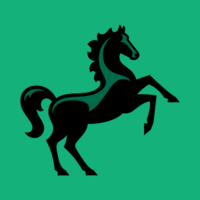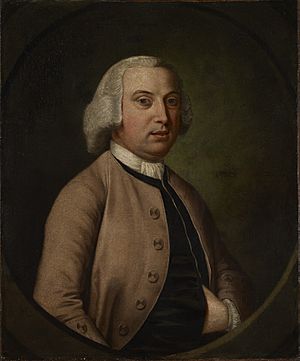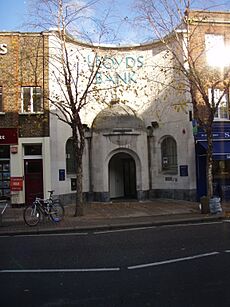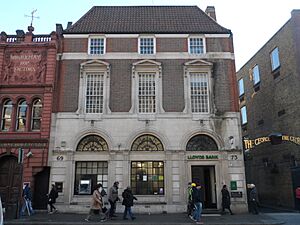Lloyds Bank facts for kids

Logo since 2024
|
|

25 Gresham Street, London
|
|
|
Formerly
|
|
|---|---|
| Public | |
| Industry | Financial services |
| Founded | 3 June 1765 (Taylors and Lloyds) |
| Founder |
|
| Headquarters | 25 Gresham Street,
,
United Kingdom
|
|
Key people
|
|
| Products | Banking and Insurance |
|
Operating income
|
£17.5 billion (2016) |
| £16.6 billion (2016) | |
| Total assets | £436 billion (2016, average interest-earning banking assets) |
|
Number of employees
|
45,856 |
| Parent | Lloyds Banking Group |
| Subsidiaries | Lloyds Bank International Limited Lloyds Bank (Gibraltar) Limited |
Lloyds Bank plc is a very important British bank. It helps people and businesses with their money. It is one of the "Big Four" banks in England and Wales. These banks handle most of the money transfers in the country.
The bank started in Birmingham in 1765. It grew a lot over the years by joining with other smaller banks. In 1995, it merged with the Trustee Savings Bank (TSB). From 1999 to 2013, it was known as Lloyds TSB Bank plc. In 2009, it became a main part of Lloyds Banking Group. This happened after Lloyds TSB Group bought another bank called HBOS. The main offices for Lloyds Bank are in London. It also has offices and data centers in other cities like Birmingham and Leeds.
Contents
The Story of Lloyds Bank
How Lloyds Bank Started

Lloyds Bank began in 1765. A button maker named John Taylor and an iron producer named Sampson Lloyd started a banking business. They set it up in Dale End, Birmingham. The first branch office opened in Oldbury in 1864.
The Taylor family stopped being involved in 1852. In 1865, Lloyds & Co. became a company called Lloyds Banking Company Ltd. This meant more people could own parts of the bank. Over time, Lloyds Banking Company joined with other banks. By 1889, it was known simply as Lloyds Bank Limited.
Bank Symbols and What They Mean
The first symbol used by Taylors and Lloyds was a beehive. This symbol stood for hard work and saving money. In 1822, they started putting a beehive on their banknotes to show they were real.
The famous black horse symbol came from a goldsmith named Humphrey Stokes in 1677. He used the black horse as a sign for his shop. His business later became part of a bank that Lloyds took over in 1884. Lloyds decided to keep the black horse symbol. The horse is shown in a special way, looking backward.
The green color of Lloyds Bank was added in the 1920s. This helped the bank stand out. For a while, both the black horse and the beehive were used. Other symbols, like the liver bird, were also used when Lloyds took over other banks. Since 1975, real black horses have even appeared in Lloyds' TV adverts!
Growing Bigger and Stronger
Lloyds Bank grew a lot by joining with many other banks. By 1923, it had taken over about 50 different banks. This helped it become one of the "Big Four" banks in the UK. One of the banks it bought was the last private company to print its own banknotes. Today, only the Bank of England can print banknotes in England and Wales.
It's important to know that some of the banks Lloyds bought had connections to businesses that used slave labor. This was a common practice in the past, but it is a sad part of history.
In 1968, Lloyds tried to merge with two other banks, Barclays and Martins Bank. But the government said no, because it would make the bank too big. In 1972, Lloyds Bank helped start the Access credit card, which is now part of MasterCard. That same year, it launched Cashpoint, the first online cash machine. Many people in the UK still call ATMs "Cashpoints."
In 1982, Lloyds Bank started getting into the estate agency business. They bought a company called Charles Hawkins and Son. This became known as Black Horse Agencies.
From 1984 to 1997, Sir Brian Pitman led the bank. He focused on making the bank more valuable for its owners. The bank also tried to buy other UK banks, but not all attempts were successful. In 1986, Lloyds Bank International joined with the main Lloyds Bank. In 1988, Lloyds created Lloyds Abbey Life by combining some of its businesses with an insurance company.
The Lloyds TSB Years
In 1995, Lloyds Bank merged with the TSB Group. This merger made them the largest bank in the UK at the time. The famous black horse logo was updated to include TSB.
In 1999, the group bought Scottish Widows, a large insurance company. In 2001, Lloyds TSB tried to buy another bank called Abbey National. But the government stopped this, saying it would not be good for the public.
In October 2011, a company called Moody's lowered Lloyds TSB's credit rating. This happened because the government was changing how much support it would give to banks. Lloyds TSB was also an official partner for the 2012 Summer Olympics in London.
Becoming Lloyds Bank Again

After the 2008 financial crisis, the government bought a large part of Lloyds Banking Group. The European Commission said the group had to sell some of its business. This was because the government's help was seen as "state aid."
So, in 2013, some Lloyds TSB branches became a new bank called TSB. This new TSB bank was later sold to another company. The rest of the business went back to being called Lloyds Bank on September 23, 2013.
In October 2014, the bank announced it would cut jobs and close some branches. This was because more customers were using online banking. In July 2016, the bank said it would cut more jobs due to economic changes. On March 17, 2017, the British Government sold its last shares in Lloyds Banking Group.
In January 2017, the bank's online services had problems. A hacker reportedly claimed responsibility for the attack.
What Services Lloyds Bank Offers
Lloyds Bank offers many banking and financial services. It has 447 branches across England and Wales. Branches in Jersey, Guernsey, and the Isle of Man are run by Lloyds Bank International Limited. Lloyds Bank (Gibraltar) Limited operates in Gibraltar. Both of these are part of Lloyds Bank.
Lloyds Bank is regulated by important authorities like the Prudential Regulation Authority and the Financial Conduct Authority. This means they make sure the bank follows the rules. The bank is also part of groups that protect customers, like the Financial Ombudsman Service.
| Range | Note |
|---|---|
| 30 to 39 | Former Lloyds branches |
| 77–00 to 77–44 77–46 to 77–99 |
Former TSB branches (England and Wales) |
The Lloyds Bank Foundation helps local and national charities. These charities work to help people who are facing difficulties in England and Wales. There are also separate foundations for Scotland, Northern Ireland, and the Channel Islands.
Lloyds Bank Around the World
Lloyds Bank started expanding overseas in 1911. By 1985, it had offices in 45 countries. These countries ranged from Argentina to the United States.
Lloyds Bank International became part of the main Lloyds Bank in 1986. Since 2010, this name has been used for the bank's offshore banking services.
Who Leads Lloyds Bank
The people who lead Lloyds Bank are also the leaders of the larger Lloyds Banking Group. Here are some of the important leaders over the years:
Chairmen of Lloyds Bank
- Timothy Kenrick (1865–1868)
- Sampson Samuel Lloyd (1868–1886)
- Thomas Salt (1886–1898)
- John Spencer Philips (1898–1909)
- Sir Richard Vassar-Smith (1909–1922)
- Lord Waddington (1922–1945)
- Lord Balfour of Burleigh (1945–1954)
- Lord Franks (1954–1962)
- Sir Harald Peake (1962–1969)
- Sir Eric Faulkner (1969–1977)
- Sir Jeremy Morse (1977–1993)
- Sir Robin Ibbs (1993–1997)
- Sir Brian Pitman (1997–2001)
- Maarten van den Bergh (2001–2006)
- Sir Victor Blank (2006–2009)
- Sir Winfried Bischoff (2009–2014)
- Lord Blackwell (2014–2020)
- Robin Budenberg (2021– )
Chief Executives of Lloyds Bank
- Sydney Parkes (1945)
- E. Whitley-Jones and A.H. Ensor (1946–1950)
- A.H. Ensor (1951–1952)
- A.H. Ensor and E.J. Hill (1953–1954)
- E.J. Hill and G.Y. Hinwood (1955–1957)
- E.J. Hill (1957–1959)
- E.J. Hill and E.J.N. Warburton (1959–1960)
- E.J.N. Warburton (1960–1966)
- M.T. Wilson (1967–1972)
- B.H. Piper (1973–1978)
- Norman Jones (1978–1983)
- Sir Brian Pitman (1984–1997)
- Sir Peter Elwood (1997–2003)
- Eric Daniels (2003–2011)
- Sir António Horta-Osório (2011–2021)
- Charlie Nunn (2021– )
See also
 In Spanish: Lloyds Bank para niños
In Spanish: Lloyds Bank para niños
- Lloyds Bank Limited v Bundy
- Lloyds Bank plc v Rosset
- Lloyds Bank plc v Independent Insurance Co Ltd





